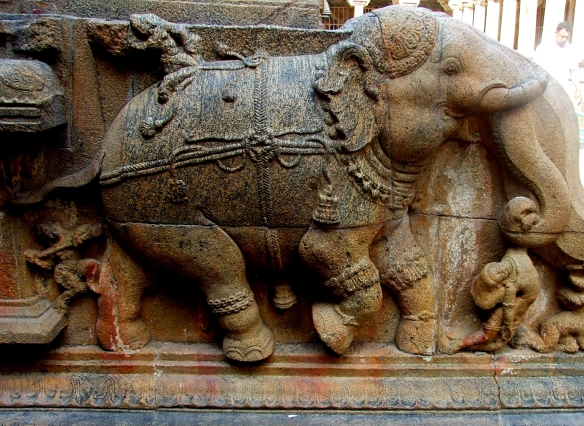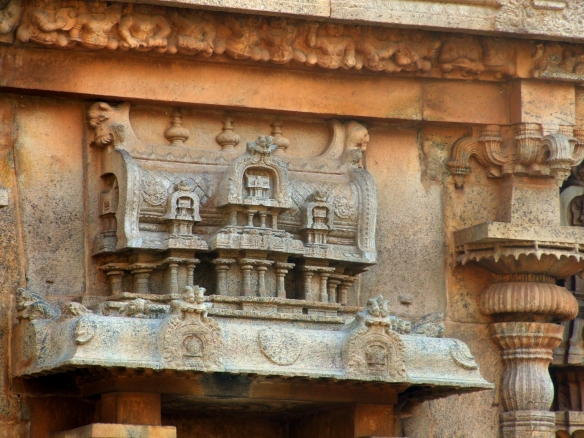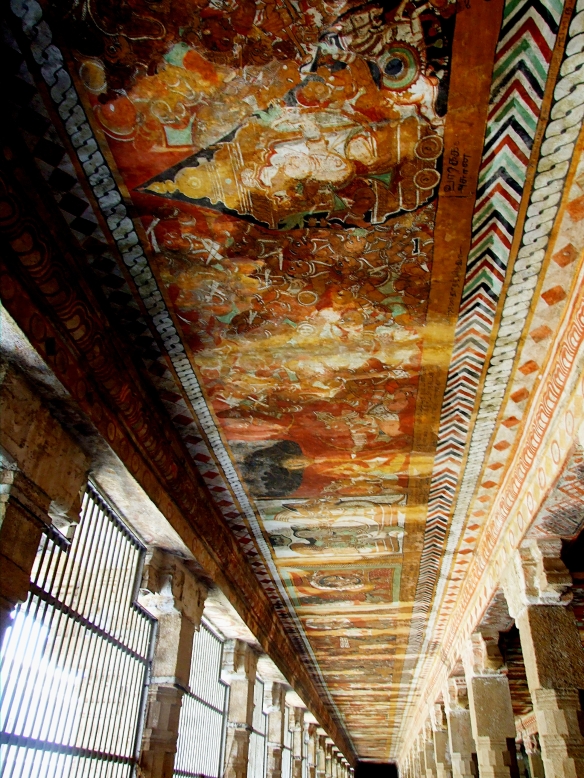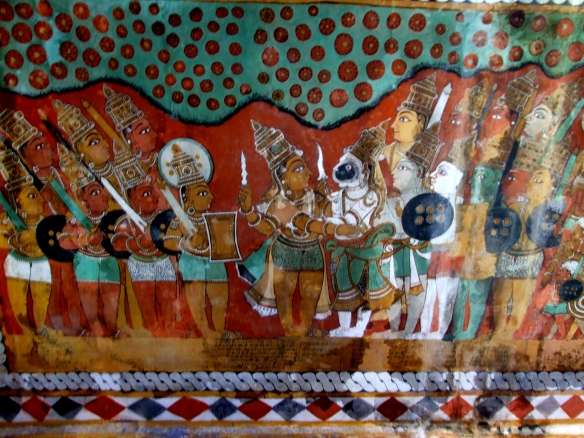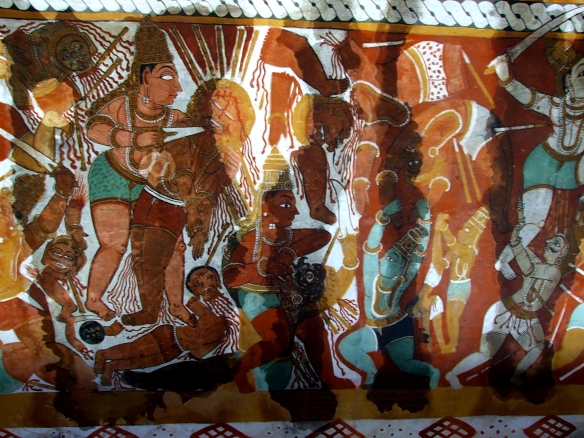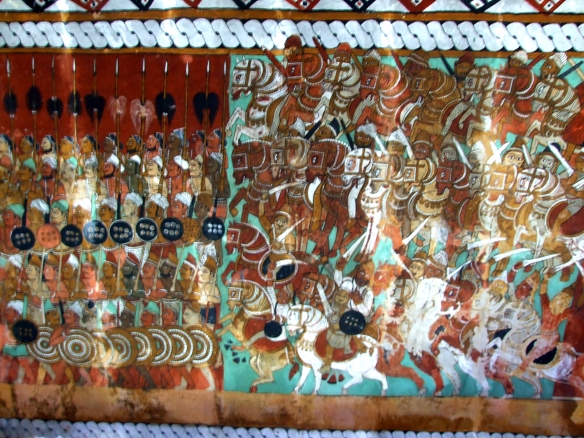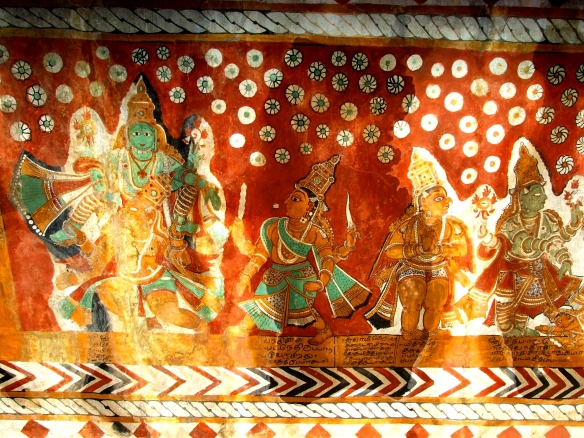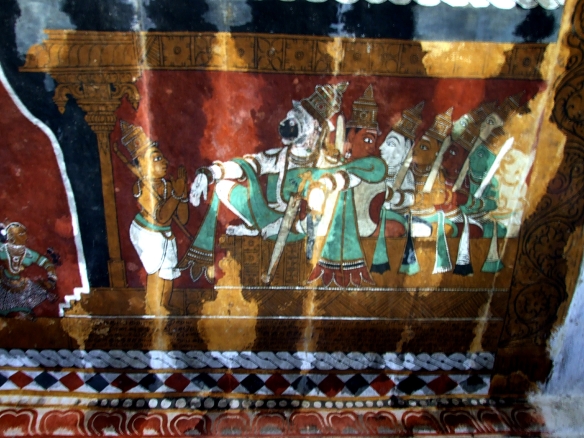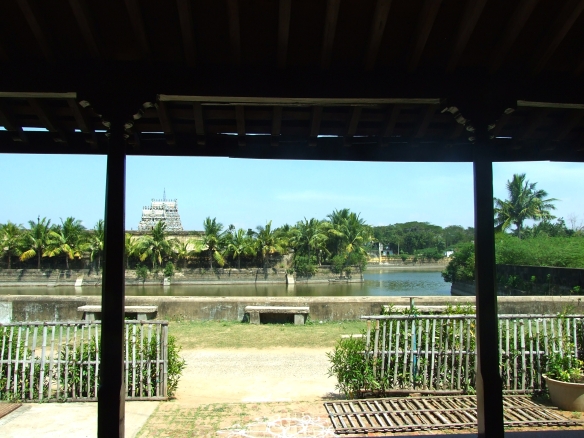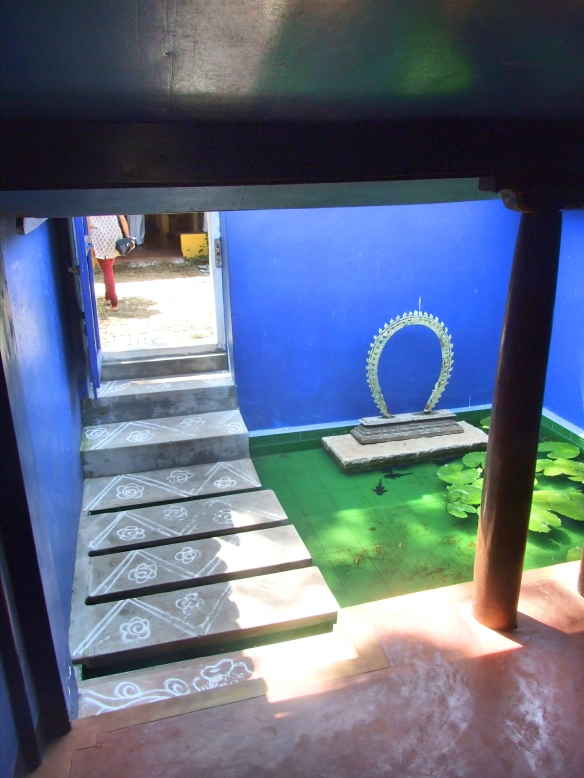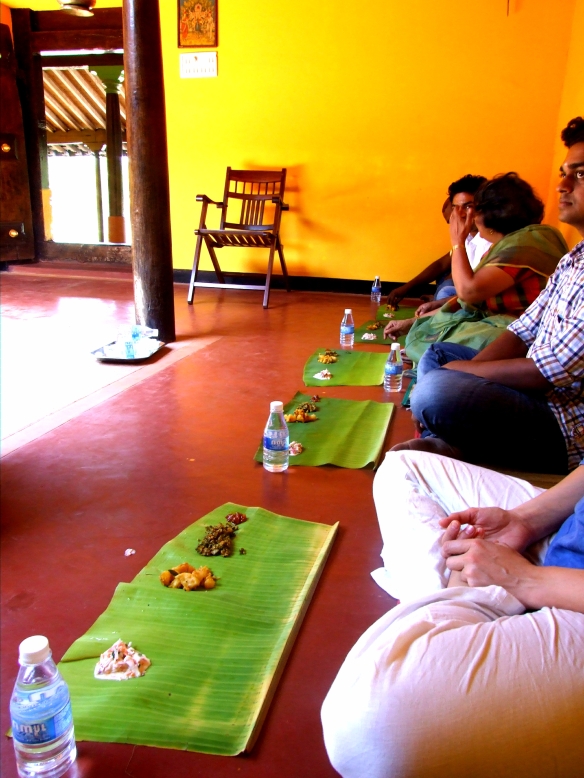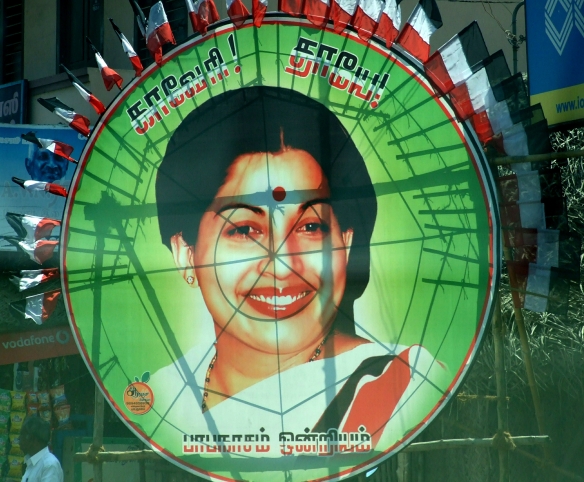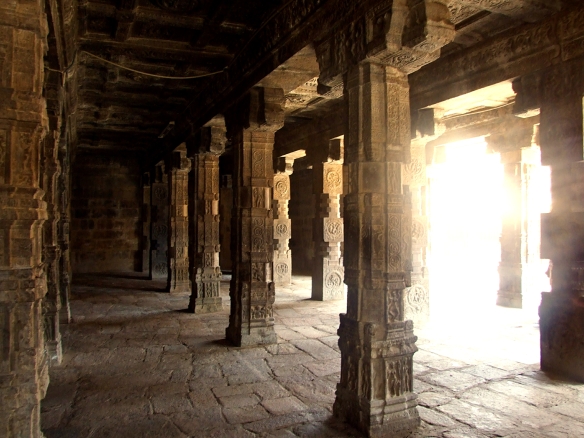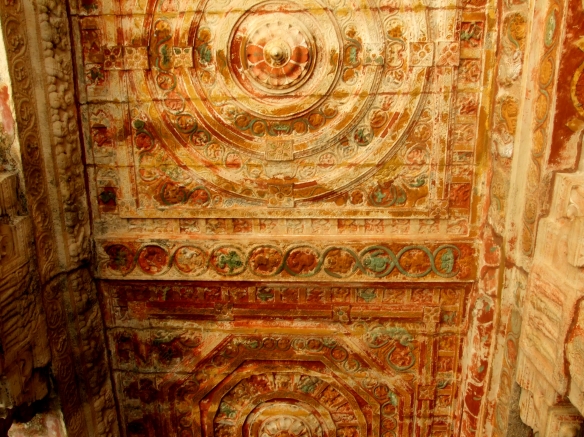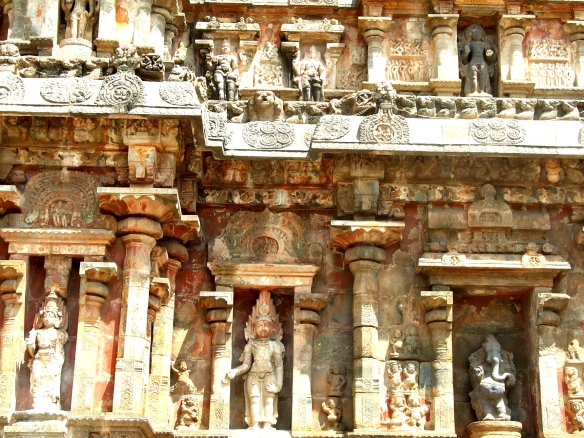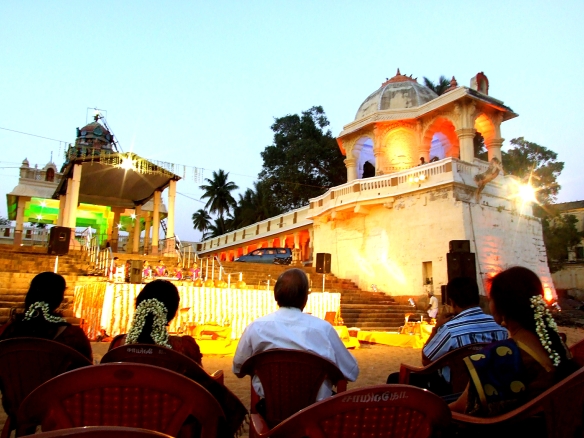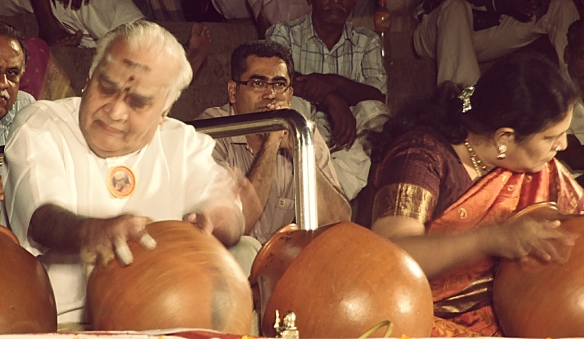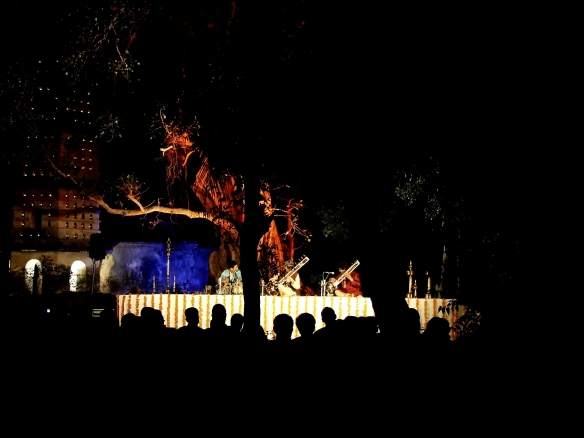Having missed the visit to the Brihadeshwara or Periya Kovil (Big Temple) – the stunning visual spectacle we passed everyday on the way to Thiruvaiyaru – the previous evening we rose early to join a few of our friends (who had also missed the previous day’s visit) to revisit and recap the architectural marvels of this surreal masterpiece made by the Chola kings in the 10th century A.D. We were taken on a guided tour of the vast compound that includes the two massive gates followed by a huge landscaped expanse that houses the main temples and makes up the temple premises. This is one of the few temples which have the top of the sanctum sanctorum towering above and beyond the gopuram (gate). The carvings are astonishing in their detail and have survived the years extremely well. So much so that a carving depicting a rope looked and even felt like a real rope down to the finest detail! We were given a swift but detailed run through of the important carvings and paintings as the day’s actual itinerary was yet to begin.
After a quick breakfast we joined the trail of the white tempo traveler that was carrying our friendly troupe to Thiruvarur, the birthplace of Swamy Tyagaraja(who is regarded as one amongst the trinity of Carnatic classical music).
It is also at the Tyagarajaswamy Temple that one of Prakriti Foundation’s main preservation/restoration projects is currently underway. One of the temple pavilions houses some incredible art depictions from the 17th century commissioned by the Chola king. A few years ago the Temple’s administration had arranged for the murals to be whitewashed into oblivion as part of a renovation process. By sheer serendipity Ranvir chanced upon them, immediately intervened and put a hold to the process by bringing in the necessary people (like INTACH) to preserve these creations instead.
As we walked into the pavilion we were handed a mirror, which made the process of viewing the murals seamless as they were on the ceiling. We were at once tantalised by the use of colour and imagery. The murals tell the story of how Tyagarajaswamy or Shiva came to reside in Thiruvarur at the behest of the monkey faced Chola King Muckunda. You will see scenes from battles fought, celebrations, flora and fauna and other general life depictions from the period. Here are a few:
For more detailed information check out a coffee table book titled ‘The Muckunda Murals’ by V.K. Rajamani and David Shulman.
The temple also houses an installation of the navagrahas. Translated as nine (nava) cosmic influencers (grahas), in Hindu astrology the position of the grahas are believed to influence the behaviour of living beings. It is typically consulted and mapped out during important junctures in one’s life e.g. birth, marriage etc. The grahas are usually positioned in a circular fashion however, at the Tyagarajaswamy Temple the grahas are in a straight line. It is believed that this is the case because the construction of the temple needed to be completed before the builders received the correct positioning from the Gods whom they were waiting on.
Owing to the heat we missed marveling at the large temple pond, barring a cursory glance while we were entering the temple premises.
We were almost immediately back on the trail of the Tempo Traveler, which was now heading to a guest house property (one of Ranvir’s) where we were going to eat lunch in traditional South Indian style. We did not know where we were going and hence did not know what to expect. After a longish, winding journey that was more like an obstacle course owing to the large number of potholes and the pitiable condition of the state highway, we reached a little village called Tirupugalur that was tucked away unexpectedly in the winding roads. We turned into a narrow village road that led up to an extremely quiet and deserted location which was behind the main village temple and tank. To our right was the Temple’s back exterior and the temple tank, which was U-shaped.To our left was one of the most eloquent homes we had ever seen – ‘Mangala Heritage Home.’ See it for yourself and tell us if you disagree !
It was a true royal treat – with the incredible ambiance of a traditional Tamil Nadu home complete with modern amenities, charming aesthetic and beautiful service with a smile. We proceeded to eat a traditional meal that was served on a plantain leaf while being seated on the floor, which is how the people in this part of the country eat all their meals(the traditionally rooted ones at least). The meal was supreme and the setting promoted it to a sublime level. (A:9 M:8.5). The whole group relaxed and sat back after the meal as they imbibed the silence and tranquil energy that was on offer. Mangala Heritage Home is truly one of a kind and seemed perfect for a soul retreat away from urban life. We are certainly going to go back soon!
After engaging in a brief interactive session the convoy headed back towards Thanjavur led by us. The evening’s program (also the last of the Sacred Music Festival) promised some more interesting performances and we definitely needed to freshen up before heading there.
As it turned out, this was not such a great plan as we later realized. The process of going to Thanjavur to rest awhile and freshen up took more time than we thought it would – especially since we’d had that comatose inducing meal – and we ended up reaching the Panchanadeeswarar temple in Thiruvaiyaru nearly two hours after the program started. Turned out we had missed the entire performance by the Dalit Nadaswaram players (who performed on the temple rooftop) and more than half of the Carnatic vocal performance by the famous Sanjay Subramanian. We caught around half an hour of his final rendition which was quite effortless – technically precise, yet subtly melodic true to the characteristics of the Carnatic style.
After the concert ended there was a round of felicitations for Prakriti Foundation and the local bodies who were involved in successfully putting together this wonderful festival for the 5th year in a row. During this point we learned about the existence of 2 music schools in Thiruvaiyaru – The Government Music College and The Marabu Foundation. Dr. Rama Kausalya who was Master of Ceremonies for all the events, was the ex-principal of the Music College and Founder of the Marabu Foundation. Unfortunately, there was not enough time and space to learn more from Dr. Kausalya as we were amongst a large number of people waiting to speak with her. However, we do intend to find out more about the types of musical knowledge that are being imparted there along with the kind of environment and setup at this school which is based out of a holy ground of music.
Back at Hotel Naynam in Thanjavur, the headquarters of the organizers as well as some from our little travel party, we enjoyed a simple meal in the company of our new friends. A few were getting ready to leave on the same night and the rest were departing the next morning like us. It was a good hour or so of reliving some moments and exchanging ideas and thoughts until we met again. We said our goodbyes and headed back to our hotel and retired early as we had a whole day of driving ahead of us.
Our trip back was mostly uneventful aided by a very satisfying meal at a restaurant (forget the name but it is on a big circle on the highway) in Salem. We chose to take the traditional route around Trichy and into Namakkal, (we went a bit off course again for about 5 kms owing to the very non-descriptive turn-off from the main highway) which was quite peaceful and took us about the same time. Post Namakkal, M took over the wheel and drove at an easy pace till the outskirts of Bangalore.
It was a great, refreshing and pleasant experience for the two of us as it not only had the perfect ingredients for the palettes of our exploratory minds, but also a fantastic setting and interesting company to make it more special than it already was. We hope to come back and not just attend but get involved in some way with this beautiful initiative that helps in throwing light on maintaining the importance of the arts, music and architecture in this region. Keep your eyes and ears open for the 2014 event as the foundation doesn’t do as many online updates a we’d like and the only way to keep posted with their activities is via their facebook page.
More explorations coming your way soon as we have enough travel on our minds !
AM

